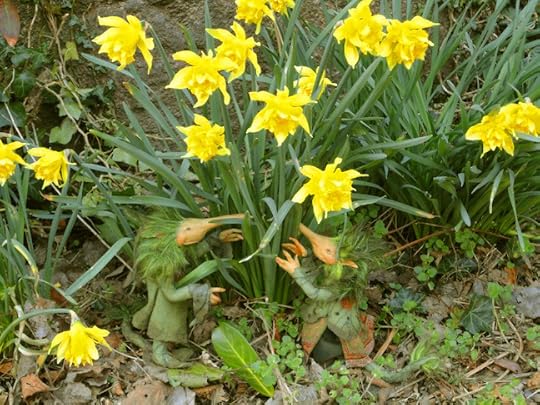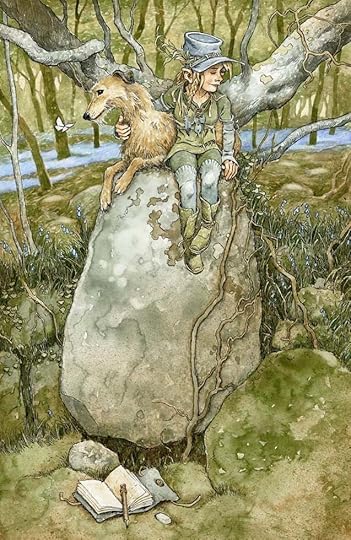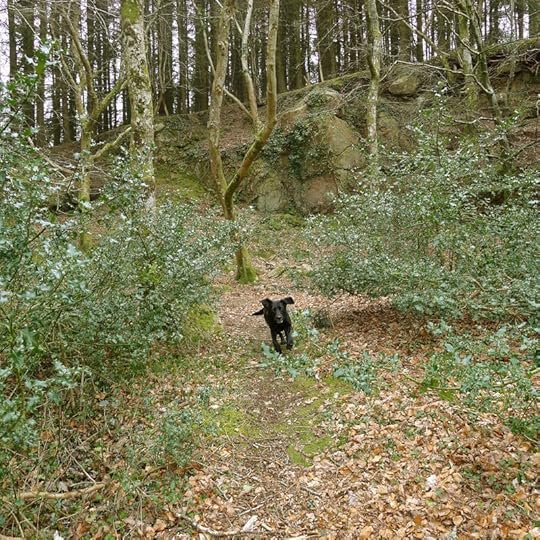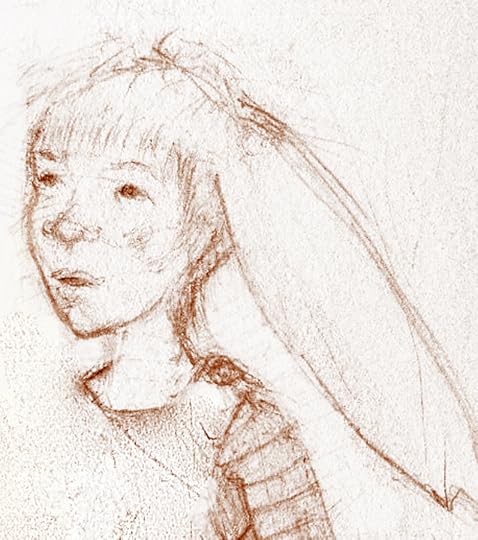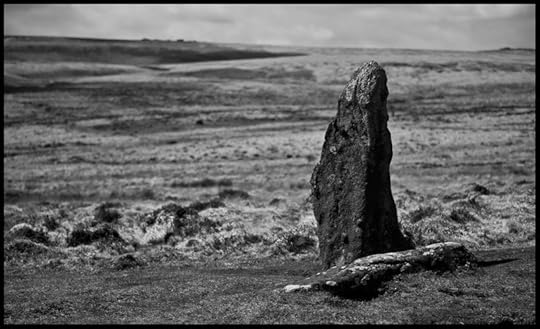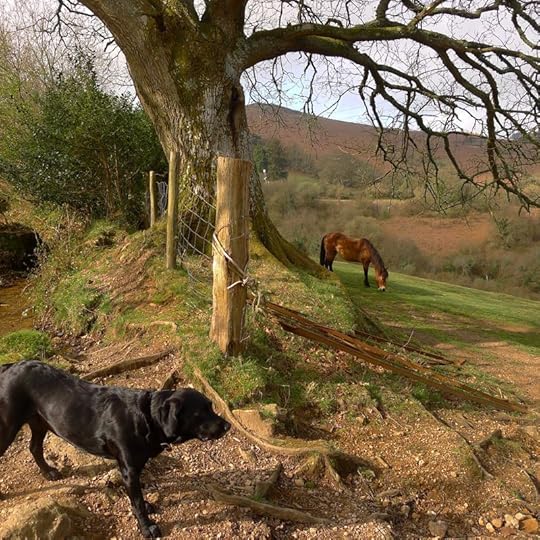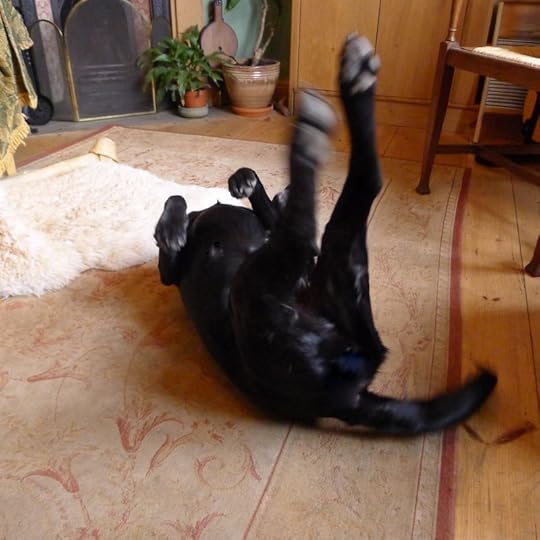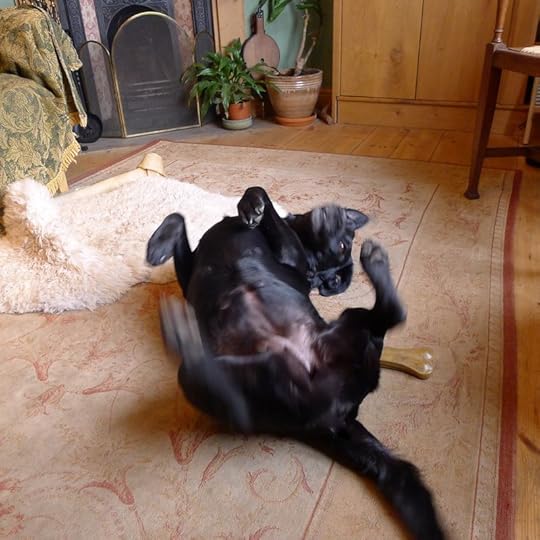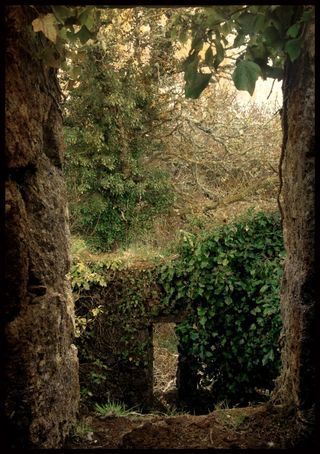Terri Windling's Blog, page 191
May 15, 2013
Into the woods, Part I
“The image of a wood has appeared often enough in English verse. It
has indeed appeared so often that it has gathered a good deal of verse
into itself; so that it has become a great forest where, with long
leagues of changing green between them, strange episodes of poetry have
taken place. Thus in one part there are lovers of a midsummer night, or
by day a duke and his followers, and in another men behind branches so
that the wood seems moving, and in another a girl separated from her two
lordly young brothers, and in another a poet listening to a nightingale
but rather dreaming richly of the grand art than there exploring it,
and there are other inhabitants, belonging even more closely to the
wood, dryads, fairies, an enchanter's rout. The forest itself has
different names in different tongues -- Westermain, Arden, Birnam,
Broceliande; and in places there are separate trees named, such as that
on the outskirts against which a young Northern poet saw a spectral
wanderer leaning, or, in the unexplored centre of which only rumours
reach even poetry, Igdrasil of one myth, or the Trees of Knowledge and
Life of another. So that indeed the whole earth seems to become this one
enormous forest, and our longest and most stable civilizations are only
clearings in the midst of it.” ― Charles Williams (The Figure of Beatrice)
"I’ve often thought of the forest as a living cathedral, but this
might diminish what it truly is. If I have understood Koyukon teachings,
the forest is not merely an expression or representation of sacredness,
nor a place to invoke the sacred; the forest is sacredness itself.
Nature is not merely created by God; nature is God. Whoever moves within
the forest can partake directly of sacredness, experience sacredness
with his entire body, breathe sacredness and contain it within himself,
drink the sacred water as a living communion, bury his feet in
sacredness, touch the living branch and feel the sacredness, open his
eyes and witness the burning beauty of sacredness.” - Richard Nelson (The Island Within)
“He stood staring into the wood for a minute, then said: 'What is it about the English countryside -- why is the beauty so much more than visual? Why does it touch one so?'
"He sounded faintly sad. Perhaps he finds beauty saddening -- I do myself sometimes. Once when I was quite little I asked father why this was and he explained that it was due to our knowledge of beauty's evanescence, which reminds us that we ourselves shall die. Then he said I was probably too young to understand him; but I understood perfectly.” - Dodie Smith (I Capture the Castle)
“All forests have their own personality. I don't just mean the obvious
differences, like how an English woodland is different from a Central
American rain forest, or comparing tracts of West Coast redwoods to the
saguaro forests of the American Southwest...they each have their own
gossip, their own sound, their own rustling whispers and smells. A voice
speaks up when you enter their acres that can't be mistaken for one
you'd hear anyplace else, a voice true to those particular tress,
individual rather than of their species.” ― Charles de Lint (The Onion Girl)
How I Go to the Woods
Ordinarily I go to the woods alone,
with not a single friend,
for they are all smilers and talkers
and therefore unsuitable.
I don’t really want to be witnessed talking to the catbirds
or hugging the old black oak tree.
I have my ways of praying,
as you no doubt have yours.
Besides, when I am alone
I can become invisible.
I can sit on the top of a dune
as motionless as an uprise of weeds,
until the foxes run by unconcerned.
I can hear the almost unhearable sound of the roses singing.
If you have ever gone to the woods with me,
I must love you very much.
Robert Pogue Harrison (author of the Forests: The Shadow of Civilization) recommends the work of four other fine poets of the forest: Andrea Zanzotto, Susan Stewart, A.R. Ammons, and W.S. Merwin. But Harrison's fear is that "the rapidity with which our society is losing daily
contact with the natural world will make it more and more unlikely that
we will have poets of the forest like Zanzotto or Merwin, or
Stewart, who grew up on a farm in the midst of Pennsylvania's forests.
The more our worlds are detached and abstracted from nature in this
daily way, the more I fear that poets will invoke the forests in only
the most superficial of ways, without the kind of full-bodied authority
that a lived relationship to the forest creates."
The late naturalist John Hay would have agreed that the forest poet must be one who knows the land, which takes both proximity and time. "There are occasions," he wrote (in The Immortal Wilderness), "when you can hear the mysterious language of the Earth: in water, or coming through the trees, emanating from the mosses, seeping through the under currents of the soil, but you have to be willing to wait and receive.”
As Tilly and I scramble over rock and root, as we do most mornings, rain or shine, I pray that our own small patch of woods remains safe, remains wild, remains here for future generations to come "home" to. I pray for patience to wait, and ears to listen, and a heart wide open, ready to receive. I want to be wild myself, like the woodland creatures in these paintings, in my quiet scribbler's way. But what is the wild? asks Louise Erdrich (in The Blue Jay's Dance). A place? A state of mind? The conjunction of these things? "What is wilderness?" she muses. "What are dreams but an internal
wilderness and what is desire but a wildness of the soul?”
Bernard Malamud's answer is simple and speaks to all of us, rural and urban, young and old. “The wild," he says, "begins where you least expect it, one step off your normal course."
All of the "wild art" above comes from artists here in the village: An illustration for JRR Tolkien's "The Hobbit" by Alan Lee, faery sculptures in the daffodils by Wendy Froud, Spring Watch by David Wyatt (from his Local Characters series), trolls by Brian Froud (from his new book "Trolls"), Telling Stories to the Trees by Rima Staines, and Wolf Boy by Danielle Barlow.
Into the woods....
“The image of a wood has appeared often enough in English verse. It
has indeed appeared so often that it has gathered a good deal of verse
into itself; so that it has become a great forest where, with long
leagues of changing green between them, strange episodes of poetry have
taken place. Thus in one part there are lovers of a midsummer night, or
by day a duke and his followers, and in another men behind branches so
that the wood seems moving, and in another a girl separated from her two
lordly young brothers, and in another a poet listening to a nightingale
but rather dreaming richly of the grand art than there exploring it,
and there are other inhabitants, belonging even more closely to the
wood, dryads, fairies, an enchanter's rout. The forest itself has
different names in different tongues -- Westermain, Arden, Birnam,
Broceliande; and in places there are separate trees named, such as that
on the outskirts against which a young Northern poet saw a spectral
wanderer leaning, or, in the unexplored centre of which only rumours
reach even poetry, Igdrasil of one myth, or the Trees of Knowledge and
Life of another. So that indeed the whole earth seems to become this one
enormous forest, and our longest and most stable civilizations are only
clearings in the midst of it.” ― Charles Williams (The Figure of Beatrice)
"I’ve often thought of the forest as a living cathedral, but this
might diminish what it truly is. If I have understood Koyukon teachings,
the forest is not merely an expression or representation of sacredness,
nor a place to invoke the sacred; the forest is sacredness itself.
Nature is not merely created by God; nature is God. Whoever moves within
the forest can partake directly of sacredness, experience sacredness
with his entire body, breathe sacredness and contain it within himself,
drink the sacred water as a living communion, bury his feet in
sacredness, touch the living branch and feel the sacredness, open his
eyes and witness the burning beauty of sacredness.” - Richard Nelson (The Island Within)
“He stood staring into the wood for a minute, then said: 'What is it about the English countryside -- why is the beauty so much more than visual? Why does it touch one so?'
"He sounded faintly sad. Perhaps he finds beauty saddening -- I do myself sometimes. Once when I was quite little I asked father why this was and he explained that it was due to our knowledge of beauty's evanescence, which reminds us that we ourselves shall die. Then he said I was probably too young to understand him; but I understood perfectly.” - Dodie Smith (I Capture the Castle)
“All forests have their own personality. I don't just mean the obvious
differences, like how an English woodland is different from a Central
American rain forest, or comparing tracts of West Coast redwoods to the
saguaro forests of the American Southwest...they each have their own
gossip, their own sound, their own rustling whispers and smells. A voice
speaks up when you enter their acres that can't be mistaken for one
you'd hear anyplace else, a voice true to those particular tress,
individual rather than of their species.” ― Charles de Lint (The Onion Girl)
How I Go to the Woods
Ordinarily I go to the woods alone,
with not a single friend,
for they are all smilers and talkers
and therefore unsuitable.
I don’t really want to be witnessed talking to the catbirds
or hugging the old black oak tree.
I have my ways of praying,
as you no doubt have yours.
Besides, when I am alone
I can become invisible.
I can sit on the top of a dune
as motionless as an uprise of weeds,
until the foxes run by unconcerned.
I can hear the almost unhearable sound of the roses singing.
If you have ever gone to the woods with me,
I must love you very much.
Robert Pogue Harrison (author of the Forests: The Shadow of Civilization) recommends the work of four other fine poets of the forest: Andrea Zanzotto, Susan Stewart, A.R. Ammons, and W.S. Merwin. But Harrison's fear is that "the rapidity with which our society is losing daily
contact with the natural world will make it more and more unlikely that
we will have poets of the forest like Zanzotto or Merwin, or
Stewart, who grew up on a farm in the midst of Pennsylvania's forests.
The more our worlds are detached and abstracted from nature in this
daily way, the more I fear that poets will invoke the forests in only
the most superficial of ways, without the kind of full-bodied authority
that a lived relationship to the forest creates."
The late naturalist John Hay would have agreed that the forest poet must be one who knows the land, which takes both proximity and time. "There are occasions," he wrote (in The Immortal Wilderness), "when you can hear the mysterious language of the Earth: in water, or coming through the trees, emanating from the mosses, seeping through the under currents of the soil, but you have to be willing to wait and receive.”
As Tilly and I scramble over rock and root, as we do most mornings, rain or shine, I pray that our own small patch of woods remains safe, remains wild, remains here for future generations to come "home" to. I pray for patience to wait, and ears to listen, and a heart wide open, ready to receive. I want to be wild myself, like the woodland creatures in these paintings, in my quiet scribbler's way. But what is the wild? asks Louise Erdrich (in The Blue Jay's Dance). A place? A state of mind? The conjunction of these things? "What is wilderness?" she muses. "What are dreams but an internal
wilderness and what is desire but a wildness of the soul?”
Bernard Malamud's answer is simple and speaks to all of us, rural and urban, young and old. “The wild," he says, "begins where you least expect it, one step off your normal course."
All of the "wild art" above comes from artists here in the village: An illustration for JRR Tolkien's "The Hobbit" by Alan Lee, faery sculptures in the daffodils by Wendy Froud, Spring Watch by David Wyatt (from his Local Characters series), trolls by Brian Froud (from his new book "Trolls"), Telling Stories to the Trees by Rima Staines, and Wolf Boy by Danielle Barlow.
May 14, 2013
The Gift of Wonder
In the lovely video above, children's book author Cornelia Funke speaks about the need for
wilderness in children's lives. "Kids are so very good at still being shape-shifters," she says, "and shifting into feathers and fur. They still understand that we are connected to everything in this world, and that we are part of an incredibly intricate woven web of life and creatures."
Raised and educated in Germany, Funke was originally a book illustrator before turning her hand to writing fiction herself -- creating magical novels such as the The Thief Lord, Dragon Rider, and The Inkheart Trilogy that have become international bestsellers. She now lives in Los Angeles.
"In a way that I haven’t yet figured out how to fully articulate, I believe that children who get to see bald eagles, coyotes, deer, moose, grouse, and other similar sights each morning will have a certain kind of matrix or fabric or foundation of childhood, the nature and quality of which will be increasing rare and valuable as time goes on, and which will be cherished into adulthood, as well as becoming -- and this is a leap of faith by me -- a source of strength and knowledge to them somehow. That the daily witnessing of the natural wonders is a kind of education of logic and assurance that cannot be duplicated by any other means, or in other place: unique and significant, and, by God, still somehow relevant, even now, in the twenty-first century. For as long as possible, I want my girls to keep believing that beauty, though not quite commonplace and never to pass unobserved or unappreciated, is nonetheless easily witnessed on any day, in any given moment, around any forthcoming bend." - Rick Bass ("The Return" )
“If I had influence with the good fairy who is supposed to preside over
the christening of all children I should ask that her gift to each child
in the world be a sense of wonder so indestructible that it would last
throughout life, as an unfailing antidote against the boredom and
disenchantments of later years, the sterile preoccupation with things
artificial, the alienation from the sources of our strength.” - Rachel
Carson (A Sense of Wonder)
“I wonder how it is we have come to this place in our society where
art and nature are spoke in terms of what is optional, the pastime and
concern of the elite?” - Terry Tempest Williams (Leap)
 This post is for Charlotte Hills and all of the other teachers out there, with gratitude for the vital work you do. The pictures above: one of the deer children from my old Desert Spritis series, and two bunny girls from a Devon sketchbook.
This post is for Charlotte Hills and all of the other teachers out there, with gratitude for the vital work you do. The pictures above: one of the deer children from my old Desert Spritis series, and two bunny girls from a Devon sketchbook.
May 13, 2013
Inhaling, Exhaling...
How to be a Poet (to remind myself)
by Wendell Berry
Make a place to sit down.
Sit down. Be quiet.
You must depend upon
affection, reading, knowledge,
skill -- more of each
than you have -- inspiration,
work, growing older, patience,
for patience joins time
to eternity…
Breathe with unconditional breath
the unconditioned air.
Shun electric wire.
Communicate slowly. Live
a three-dimensional life;
stay away from screens.
Stay away from anything
that obscures the place it is in.
There are no unsacred places;
there are only sacred places
and desecrated places.
Accept what comes from silence.
Make the best you can of it.
Of the little words that come
out of the silence, like prayers
prayed back to the one who prays,
make a poem that does not disturb
the silence from which it came.
(from Given: New Poems)
"The world is holy. We are holy. All life is holy. Daily
prayers are delivered on the lips of breaking waves, the whisperings of
grasses, the shimmering of leaves." - Terry Tempest Williams (Leap)
“I breathe in the soft, saturated exhalations of cedar trees and salmonberry bushes, fireweed and wood fern, marsh hawks and meadow voles, marten and harbor seal and blacktail deer. I breathe in the same particles of air that made songs in the throats of hermit thrushes and gave voices to humpback whales, the same particles of air that lifted the wings of bald eagles and buzzed in the flight of hummingbirds, the same particles of air that rushed over the sea in storms, whirled in high mountain snows, whistled across the poles, and whispered through lush equatorial gardens…air that has passed continually through life on earth. I breathe it in, pass it on, share it in equal measure with billions of other living things, endlessly, infinitely.” - Richard Nelson (The Island Within)
“Breathing involves a continual oscillation between exhaling and
inhaling, offering ourselves to the world at one moment and drawing the
world into ourselves at the next.” - David Abram (Becoming Animal)
Making art is like breathing. Creation is the exhalation, putting ideas,
emotions, patterns, rhythms, and revelations of beauty out into the
world through the materials of our chosen art forms. But first comes the inhalation. We can't produce and produce without stopping to breathe. We must take the world in: land and wind, books and song, love and passion, silence and conversation; all those
things that inspire us, fill us, delight us, enrage us, alchemize into art inside of us; all
those things that form and change and batter our lives and give us something to say; all those things that, mixed together in unique proportions, give us tales that are truly our own.
The Dartmoor photographs here are, once again, by Stu Jenks, from his visit here a couple of weeks ago. Above: "Standing Stone Near Merrivale," "Scorhill Circle," "Tallest
Stone: Scorhill Circle," "Three Stones: Scorhill Circle," and "White
Pony at Scorhill Circle." (Click on the images for larger versions.)
Below: "A Brown Pony Rubbing His Ass Against An Ancient Stone, A
White Pony Scratching Her Neck Against Another." About this one, he says:
"This, in visual metaphor, pretty much expresses my spiritual belief of
finding the balance between the sacred and the profane."
May 12, 2013
Tunes for a Monday Morning
Today's first tune, on this May morning so early, is a Flemish song called "The Maying Song" -- performed by the English folk musician Bella Hardy, with Ian Stephenson and Chris Sherburn. (Ignore the obnoxious advertisement at the video's start -- it goes away soon!)
Hardy, who is from the Peak District in Derbyshire, has five fine albums to date. This is a performance from 2008, because there aren't many good Hardy videos available, alas. If you'd like to hear a bit more of her music, try "The Driving of the Deer," from last year's CD, The Dark Peak and the White. And I particularly recommend her latest album, Battleplan, in which "traditional ballads are re-imagined from a female perspective, and
personal experiences are reflected against fairy tales and folklore."
Next: another "roving out" song, but a bawdier version this time, sung by
Kathryn Roberts. You may remember Roberts from her younger days, when
she recorded a lovely debut CD with Kate Rusby. Now she's teamed up with her
husband Sean Lakeman (Seth's brother), performing both original
and traditional material. They've released three albums (1, 2, and Hidden People), and all of them are good.
Below: Kathryn Roberts again, solo this time, performing her "Ballad of Andy Jacobs" -- a sad and beautiful song about the miners' strikes under Thatcher, inspired by her childhood in a Yorkshire mining town. (She talks about this briefly at the end of the video.) This one is timely too, with Britain still reeling from Thatcher's divisive funeral.
Below, Kris Drever, with another poignant song about another tragic time in the UK's history: "The Poorest Company," about the Highland clearances. Drever, who is from the Orkney Isles of Scotland, has played with Kate Rusby, Eddi Reader, Julie Fowlis, and is one of the founding members of Lau. Here, he's performing at Celtic Connections in Glasgow, with Roddy Woomble, John McCusker, and Heidi Talbot. Although I like his CDs with Lau the best (they're just astonishingly good), his solo albums Black Water and Mark the Hard Earth are also very fine, as is Before the Ruin with Woomble and McCusker.
I was going to stop there, but let's end on a more hopeful note...
Below: "Start it all Over Again," an old Battlefield Band song exquisitely performed by Irish singer Heidi Talbot -- backed up by her husband, Scottish fiddler John McCusker, and Boo Hewerdine. Talbot, formerly of Cherish the Ladies, has released five solo albums, of which I especially like the latest, Angel Without Wings.
If you stutter or stumble, if dreams start to crumble
I'll pick up the pieces of pain.
I will cradle you, cry with you, pray that tonight we'll just
start it all over again...
Beautiful.
May 11, 2013
The Dog's Tale
I am the luckiest dog in the world, with woods and hills and fields to roam in, rivers to jump in, fox poo to roll in, and plenty of squirrels to chase. Every day brings new surprises. Sometimes a deer bounds through the trees, or I flush a pheasant out of the grass. Sometimes I discover fresh animal dens, or wildflowers growing in a perfect circle where fairy feet have danced. (We dogs can see the fairies, of course.)
This week I spied a strange dark shape behind the old oak at the bottom of the hill. I thought it might be hedge witch or a troll (I found a troll quite close by last year) ...
...but it was another wild pony, down from the moor. And she wasn't alone.
Behind her was a foal, still wobbly on its legs. I kept my distance, as I've been trained, but I wagged my tale, and the foal came walking over...and then the Mama Pony did the funniest thing.
She knealt down on the grass, rolled over and over, and kicked her legs. What fun!
First she rolled left, and then she rolled right...
...and then she rolled some more.
The foal battted her big eyes at me while the Mama jumped up and shook her tail...
...then Baby wobbled over to Mama, had a little cuddle...
and they trotted away.
At home, I demonstrated for my People.
"First she kicked her legs like this," I said,
"and then like this and this."
I often do interpretive dance, and now I've learned some excellent new moves.
My People liked my Pony Dance much better than the last one, my Fox Poo Dance. This time I got a nice new bone. Last time it was a bath and a telling off....
May 10, 2013
I'm delighted to pass on the following Public Service...
I'm delighted to pass on the following Public Service Announcement from my husband Howard and his elusive friend Rex...
The Barleycorn Boys Are Back in Town!
Guess who just got back today? Howard and Rex, those wild eyed boys who’ve been away.
We’ve been off the grid for a bit, wrestling with our creative muses. (Literally, in Rex’s case; he’s muddy and bruised!) Now spring has sprung, and we’re back in the virtual world, and we have a trinity of delights to share:
1. We’re now posting our complete graphic novel, John Barleycorn Must Die, online at a page a day on our new John Barleycorn blog. If you haven’t read it yet, now’s your chance.
The new blog: http://jbmdfalloftheskygods.blogspot.co.uk/
2. We also have a John Barleycorn Tumblr site, where we’ll be posting art work from the comic every day. (Just art, no text.) If you have a Tumblr account, please come follow us!
The new Tumblr: http://jbmdcomic.tumblr.com/
3. Rex now has a Facebook page (god help us!), called Rex Van Ryn Presents. He’ll be discussing all things comics related (artists who started in comics, celebrities who are comic enthusiasts, etc.), and providing links to what is happening in the comics world at the moment, particularly independent comics. It’s all just getting started, so please come join in the conversation (and keep an eye on Rex!)
Facebook: https://www.facebook.com/pages/Rex-Van-Ryn-presents/459383104138082
Please join us on any or all these sites -- and if you know anyone interested in comics, would you please help us boost the signal?
It’s good to be back!
Howard & Rex
Picture above: Rex, Howard, Tilly, and Rex's invisible dog, who is also called Rex.
May 9, 2013
Messengers and mysteries
"I want to extoll not the sweetness or placidity of the dog, but the
wilderness out of which he cannot entirely step, and from which we
benefit. For wilderness is our first home too, and in our wild ride into
modernity with all its concerns and problems we need also all the good
attachments to that origin that we can keep or restore. Dog is one of
the messengers of that rich and still magical first world. The dog would
remind us of the pleasures of the body with its graceful physicality,
and the acuity and rapture of the senses, and the beauty of forest and
ocean and rain and our own breath. There is not a dog that romps or runs
but we learn from him....
"Because of the dog's joyfulness, our own is increased. It is no small
gift. It is not the least reason we should honor as well as love the dog
of our own life, and the dog down the street, and all the dogs not yet
born. What would life be like without music or rivers or the green and
tender grass? What would this world be like without dogs?"
- Mary Oliver (Long Life)
You could grow into it,
that sense of living like a dog,
loyal to being on your own in the fur of your skin
able to exist only for the sake of existing....
You swell into survival,
you take up the whole day,
you’re all there is,
everything else is
not you, is every passing glint, is
shadows brought to you by wind...
- Ioanna Carlsen (from her poem "Over and Over Tune")
“In a society
so estranged from animals as ours, we often fail to credit them with
any form of language. If we do, it comes under the heading of
communication rather than speech. And yet, the great silence we have
imposed on the rest of life contains innumerable forms of expression.
Where does our own language come from but this unfathomed store that
characterizes innumerable species?
"We
are now more than halfway removed from what the unwritten word meant
to our ancestors, who believed in the original, primal word behind
all manifestations of the spirit. You sang because you were answered.
The answers come from life around you. Prayers, chants, and songs
were also responses to the elements, to the wind, the sun and stars,
the Great Mystery behind them. Life on earth springs from a
collateral magic that we rarely consult. We avoid the unknown as if
we were afraid that contact would lower our sense of self-esteem.”
- John Hay (A Beginner's Faith in Things Unseen)
"I realized it for the first time in my life: there is nothing but mystery in the world, how it hides behind the fabric of our poor, browbeat days, shining brightly, and we don't even know it.”
- Sue Monk Kidd (The Secret Life of Bees)
"Love is a powerful tool, and maybe, just maybe, before the last
little town is corrupted and the last of the unroaded and undeveloped
wildness is given over to dreams of profit, maybe it will be love,
finally, love for the land for its own sake and for what it holds of
beauty and joy and spiritual redemption that will make wilderness not a
battlefield but a revelation."
- T.H. Watkins (Red Rock Chronicles)
May 8, 2013
Circles, stones, stories
" 'All beginnings wear their endings like dark shadows," says astronomer-physicist Chet Raymo. And maybe they do. If endings are foreshadowed by their beginnings, or are in some way the same thing, it is important that we circle around and come back to look at our human myths and stories. Unlike the cyclical nature of time for the Maya, the Western tradition of beliefs within a straight line of history leads to an apocalyptic end. And stories of the end, like those of the beginning, tell something about the people who created them....
"Without deep reflection, we have taken on the story of endings, assumed the story of extinction, and have believed that it is the certain outcome of our presence here. From this position, fear, bereavement, and denial keeps us in the state of estrangement from our natural connection with land.
"We need new stories, new terms and conditions that are relevant to the love of land, a new narrative that would imagine another way, to learn the infinite mystery and movement at work in the world. It would mean we, like the corn people of the Maya, give praise and nurture creation.
"Indian people must not be the only ones who remember the agreement with
the land, the sacred pact to honor and care for the life that, in
turn, provides for us. We need to reach a hand back through time and a
hand forward , stand at the zero point of creation to be certain we do
not create the absence of life, of any species, no matter how
inconsequential they might appear to be. "
-- Linda Hogan (Dwellings: A Spiritual History of the Living World)
"It is in our nature to need stories. They are our earliest sciences, a
kind of people-physics. Their logic is how we naturally think. They
configure our biology, and how we feel, in ways long essential for our
survival.
"Like our language instinct, a story drive -- an inborn hunger for story
hearing and story making -- emerges untutored universally in healthy
children. Every culture bathes their children in stories to explain how
the world works and to engage and educate their emotions. Perhaps story
patterns could be considered another higher layer of language. A sort of
meta-grammar shaped by and shaping conventions of character types,
plots, and social-rule dilemmas prevalent in our culture."
- Jag Bhalla ("It is Our Nature to Need Stories," Scientific American)
"The sense of being immersed in a sentient world is preserved in
the oral stories and songs of indigenous peoples -- in the belief that
sensible phenomena are all alive and aware, in the assumption that all
things have the capacity of speech. Language, for oral peoples, is not a
human invention but a gift of the land itself."
- David Abram (The Spell of the Sensuous)
The lands around my dwelling
Are more beautiful
From the day
When it is given me to see
Faces I have never seen before.
All is more beautiful.
All is more beautiful.
And life is thankfulness.
These guests of mine
Make my house grand.
- Eskimo song
Deep peace of the running wave to you.
Deep peace of the flowing air to you.
Deep peace of the quiet earth to you.
Deep peace of the shining stars to you.
Deep peace of the infinite peace to you.
- Gaelic blessing

The images in this post are by the American photographer Stu Jenks, who was visiting us here just recently, taking many beautiful Dartmoor photographs. (I know Stu from my Arizona days, when we had studios in the same building in downtown Tucson.) To see more of his work, visit his website & blog, where he'll be adding other images from his travels in England and France in the days to come.
Above: "Scorhill Circle," "Meldon Hill, Chagford," "Ancient Oaks in Wistman's Wood," "Princep's Folly in Gidleigh Wood," "The Mangler's Tower," and "Moorland Stream Near Merrivale." Below: "Chagford from Meldon Hill" and "Tilly and Daffodils on Nattadon Hill."
Click on the photographs to see larger versions.
Coming up...
This exhibition at Green Hill Arts in Moretonhampstead will feature work by Chagford artists Alan Lee, Virginia Lee, Brian & Wendy Froud, David Wyatt, Rima Staines, and yours truly, along with Hazel Brown, Paul Kidby, and Neil Wilkinson Cave. It's running most of the summer, so if you're local or making a trip down to Devon, keep it in mind...
There will also be a program of events (talks, readings, workshops, etc.). For more information, go to Green Hill Arts.
Terri Windling's Blog
- Terri Windling's profile
- 707 followers







